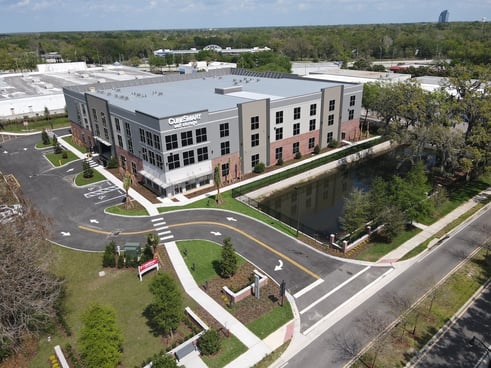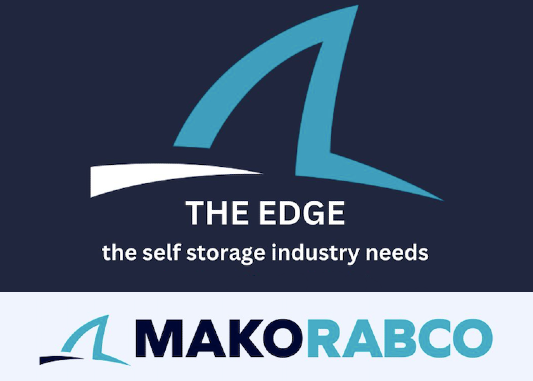The self-storage industry has experienced notable changes in recent years, especially in the realm of facility development. When entering self-storage ownership, developers have many options to choose from, two of them being: acquiring and renovating existing properties or building new facilities from scratch. While many self-storage companies still opt for acquiring properties at a lower cost and transforming them into modern facilities, it has become more challenging to find and make these opportunities financially viable. As a result, some development companies have shifted their focus towards constructing brand-new, cutting-edge self-storage facilities. In this article, MakoRabco speaks with Ted Bolin, the founder of Flagship Companies Group, as he discusses the company’s transition from buying existing properties to building new facilities.
Considerations When Buying Self Storage Properties
Back in 1999, Bolin formed Flagship Companies Group with a focus on residential development. However, in 2009, amidst changes in the economy, an opportunity presented itself to acquire self-storage properties. The downturn had led to properties being available at prices significantly lower than their replacement cost. This prompted Flagship Companies Group to partner with real estate investment trusts and venture into the acquisition of self-storage properties in California, Ohio, the Carolinas, and Florida.

Economic Factors
While the initial focus was on acquiring existing facilities, factors in the market would change their approach. During the economic downturn around 2008-2009, buying existing properties at a lower cost allowed for significant profit opportunities. However, by 2014 as the economy recovered, there was a reduced availability of underperforming properties, making the construction of new facilities more attractive. Building new facilities also provides developers with greater control over design, technology integration, and the ability to create state-of-the art spaces tailored to meet the evolving needs of customers. Many of the existing facilities that were available were dated and would require renovations and upgrades before they would be marketable, so having control over the features from the beginning became a large advantage. Numbers now favored the construction of brand-new facilities.
Operational Factors
One of the other factors that played into the Flagship Companies Group decision to transition into building new facilities over acquiring pre-existing ones is the operation of the facilities. After acquiring a facility, a third-party self-storage management company would be brought in to run the facility for Flagship Companies Group. However, third-party management companies have standards that the facilities must meet in order to operate them. This posed problems when acquiring pre-existing facilities as these facilities are often older and require a lot of work to get them up to modern standards. This scenario is another advantage of building a new facility has over buying pre-existing. When you build a brand new facility, you can control all aspects of the facility, helping make sure it meets all the requirements of a third-party management company.
Competitive Factors
Investing in the construction of a new and modern self storage facility is a strategic move that not only attracts reputable third-party management companies to oversee operations, but also sets your facility apart from the competition. By offering modern amenities, your facility will capture the attention of potential customers, making it the go-to choice for their storage needs. A visually appealing facility that provides top-notch services will not only generate positive reviews and word-of-mouth recommendations, but it will also establish your facility as a leader in the area.
Considerations When Building Self Storage Properties
But building a new self-storage facility is not as straightforward as choosing an empty lot and building the facility. The decision to build new facilities requires thorough market research and feasibility analysis.
Self Storage Supply
Key metrics, such as the supply of self-storage within a 3-to-5-mile radius, are essential in determining whether a new facility would be viable. According to Bolin, “The self-storage industry has established that a supply market is in the eight square foot per population count range. For example, if you have 100,000 people in a three-mile radius and you have a million square feet of existing supply, that is ten square feet per person. So, that would be considered a supply market, and you might not want to build there.” By examining the existing supply in relation to population count, developers can identify potential locations for new facilities.
Layout and Design
Building a new self-storage facility involves various considerations when it comes to the layout and design. There are several unique designs for self-storage facilities that can be built, so choosing the right one to maximize the site is crucial. For Bolin, many of the facilities he originally acquired were single story basic facilities, but he found these types of facilities dated and not as appealing.
“You know, there can be an oversupply of drive-up, single-story storage,” says Bolin. “The market tends to look at those older facilities and parse that in your analysis of competition because obviously there’s more of that in most markets. So, you can discount some of that supply as not direct competition to a brand-new three-story state of the art facility.”
Bolin continues, “When we study a site for a brand-new state of the art facility, you know we’re typically going to go in and build a three-story light gauge steel building block first floor, insulated panels for your second and third floor, with a standing seam metal roof. It’s a light gauge product on a ten-by-ten grid.” Bolin explains that these sorts of features can make up the core of the building, but aesthetics can vary depending on local regulations and requirements. Some counties may demand more elaborate designs, while others allow for a simpler approach. Some may even have specific landscaping requirements for building.
Community Pushback
When Bolin built his first self-storage facility in Winter Garden, Florida, he had to deal with some push back from the local government. While the area was found to be prime for a self storage facility, the local city government was not enthusiastic about having this facility built so close to homes.
“It’s a beautiful property as you drive down the turnpike, but when we met with the city of Winter Garden, it wasn’t exactly what they envisioned for that property. It’s surrounded by residential. But as we talked about it, the staff agreed to support self-storage on the site,” says Bolin. “We determined the community would embrace and needed self storage in that market. If you look at that whole residential section south of the turnpike, there’s an open area there with storage, but not enough storage to supply the market. We were down below four-square feet per population count and so we knew the community would embrace that convenient self-storage property south of the turnpike.”
Looking at the feasibility of a new self-storage facility in the area ended up being a crucial step needed to help convince the local government to allow the facility to be built. Since its opening, the facility has done very well and was fully leased faster than they were expecting.
While buying pre-existing facilities will still make sense in some cases, developers have taken note of a shift from buying pre-existing facilities to building new ones. Bolin’s experiences with Flagship Companies Group highlight the opportunities and advantages associated with constructing state-of-the-art self-storage facilities. Through meticulous market research, feasibility analysis, and strategic partnerships with third-party management companies, developers can navigate this evolving landscape and create successful and profitable ventures in the self-storage sector.
Considering building? Click below to contact MakoRabco and learn more about the company that helped the Flagship Companies Group create such a successful portfolio of self storage developments.















